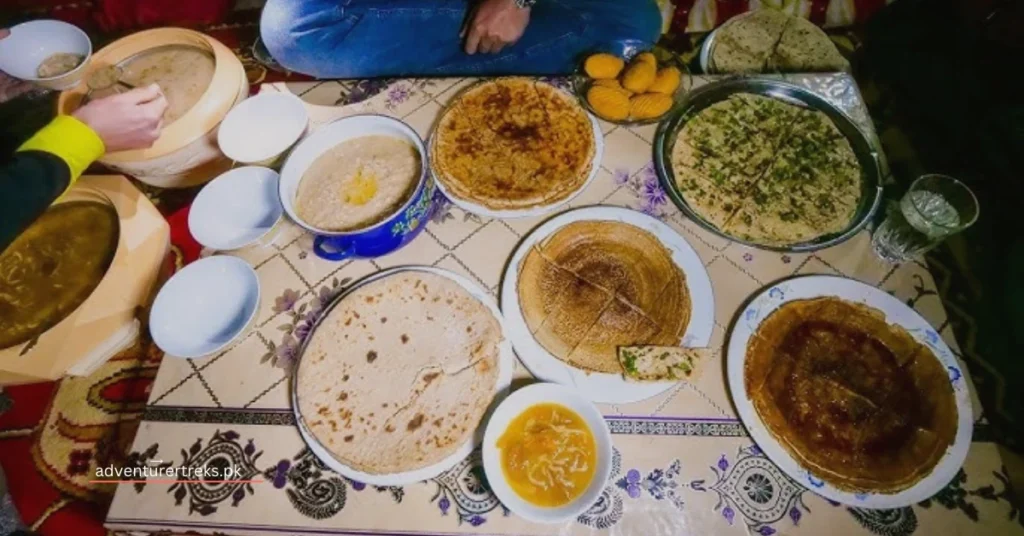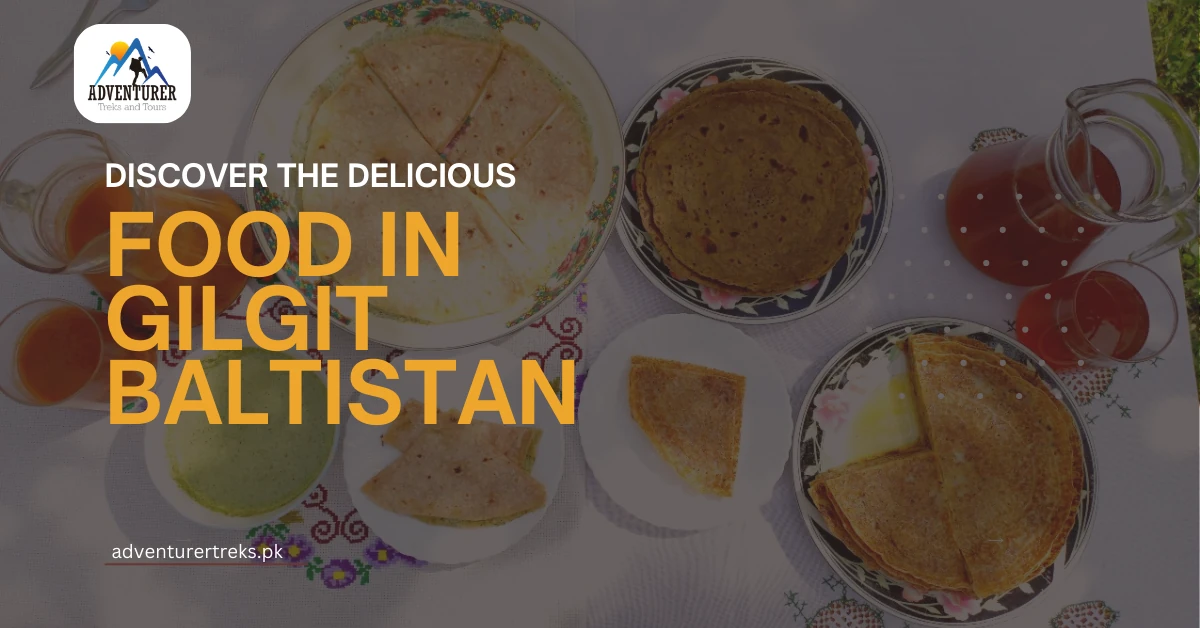Gilgit Baltistan is situated in the northern part of Pakistan. The region of Gilgit Baltistan is divided into two parts: Gilgit, which mostly has its history, and other are the Balti, which keeps a separate identity in the world. Nature has bestowed beautiful natural places to Gilgit Baltistan.
Moreover, Gilgit Baltistan is surrounded by beautiful towering peaks like k2 and Rakaposhi, the world’s highest peaks. There are many places for outdoor activities, such as skiing, hiking, trekking, boating, and fishing, which attract visitors to visit Gilgit Baltistan once in their lives.
Furthermore, Gilgit Baltistan has a rich history in cultural food. Food in Gilgit Baltistan is significant in attracting people and enjoying the local delicious foods. Food in Gilgit Baltistan is served according to season. Therefore, if you are looking to explore the foods of Gilgit Baltistan. Don’t worry; we are here to help you with the food in Gilgit Baltistan.
Food in Gilgit Baltistan
Gilgit Baltistan is famous for the basic ingredients and common dishes in Gilgit Baltistan. Visitors keenly interested in exploring traditional food don’t forget about the food of Gilgit Baltistan.

Mainly, the foods are prepared with natural ingredients, and visitors enjoy the traditional food every season. Some of the food in Gilgit Baltistan is mentioned below.
Basic Ingredients
Many basic ingredients are produced in the Gilgit Baltistan, but some of the most important ingredients are mentioned below.
Wheat
Weat is a fundamental and most important ingredient in Gilgit Baltistan’s food. Wheat can be used for bread, roti, naan, etc. Wheat production in Gilgit Baltistan is insufficient, but the government subsidized the wheat.
Barley:
Barley is another famous ingredient in the region of Gilgit Baltistan. It is mostly used in dishes and beverages. The production of barley is extensive.
Maize:
Maize is also a famous ingredient in Gilgit Baltistan. The local people of Gilgit Baltistan use maize for soups or breeds.
Dairy products:
Dairy Products milk, yogurt, butter, and cheese are the main dairy products. The people of Gilgit Baltistan mainly keep livestock, such as goats, yolk, and lamb. They take out the milk from these livestock and then make things from the milk and cook the food with local oil, which makes the food much more delicious.
Meat:
Meat livestock is also used for meat, which is very natural because livestock eat the natural things in Gilgit Baltistan, and the water they drink is mixed with natural vitamins.
Apricot:
Apricots are a popular ingredient in Gilgit Baltistan. Apricot production is extensive in GB, and the people use fresh and dried jams.
Mulberries:
Mulberries are typically used in the winter season and are dried fruit stored for the cold weather.
Local vegetables:
Local vegetables, like turnips, spinach, beans, and potatoes, are grown extensively locally. However, these are the best ingredients and are used for many dishes.
Traditional dishes
Gilgit Baltistan is renowned for its rich cultural history, and its traditional dishes are famous all over the country. However, the dishes reflect the local culture of Gilgit Baltistan, and the cooking techniques are old; people transfer this cultural heritage to the next generation.
Chapshuro:
Chapshuro is a savory pie popular in Gilgit Baltistan’s food. The Chapshuro’s technique is to keep the mixture of wheat and fill it with meat, only mutton or beef, and then mix the vegetables like onions, green chilies, and other spices. This is delicious food.
Mamtu:
The tradition of Mamtu food reflects the traditions of Central Asian countries. Mamtu is a famous dish in Gilgit Baltistan. The recipe for mamtu is ready with a mix of spices and onions and typically beef and mutton mix.
Harissa
Harissa is another delicious food that makes the history of Gilgit Baltistan much richer. Various spices, such as chicken and mutton, wheat, and meat, combine for the harissa recipe. It is a traditional dish prepared for unique events like religious festivals or other happiest moments.
Balay (Noodle soup):
Balay is a handmade dish locally called a noodle soup. It is a very old dish in Gilgit Baltistan which is always used in the days of winter. Furthermore, the Balay is prepared with meat, like mutton, chicken, and a mixture of vegetables.
Dirim fitting:
This is the famous sweet dish of Gilgit Baltistan, prepared with germinated wheat. It is served with tea and butter, especially during breakfast, and is mainly used in the Hunza region.
Marzan:
Marzan is another traditional dish of Gilgit Baltistan. It is also a type of bread made from wheat flour. This food is prepared in a clay oven, and it is used daily in the majority of houses. Therefore, the role of wheat is extensive.
Dumplings (Koftas and Mantus):
Balls of Koftas are made from the meat and prepared with much gravy. While Mantus are cooked dumplings, the origin of these dishes is central Asia. It is the influence of central Asia owing to the Silk Road.
Beverages of Gilgit Baltistan
Gilgit Baltistan is a rugged terrain area in Pakistan. The beauty of Gilgit Baltistan attracts nature lovers, adventurers, and photographers to visit Gilgit Baltistan. Moreover, the people of Gilgit Baltistan are hospitable, serving the guests with local food and beverages.
Here, I will discuss the local beverages of Gilgit Baltistan.
Chai (tea):
Chai is a famous beverage in Gilgit Baltistan that has been served repeatedly. Two types of tea are preferred mostly, including butter tea and green tea.
- Butter tea: butter tea is also called ‘Gur Gur chai.’ The tea that comes in this beverage is salt, black tea, and yak butter.
- Green tea: Green tea is used repeatedly locally; people think it has medical properties.
Chang:
Chang is another famous traditional drink of Gilgit Baltistan. It is a locally alcoholic beverage used at happy moments or other events. It is culturally linked.
Lassi:
Lassi is made from yogurt and is used extensively throughout Gilgit Baltistan. So, you can drink the Lassi in two flavors: sweet and salty. It depends on the drinker’s preferences.
Sattu:
Sattu is made from wheat flour and barley. It is most used in Gilgit Baltistan. It is used in summer or during Ramzan fasting, providing a lot of energy to the body.
Modern influences and fusion cuisine
Tourism influence:
Nature lovers, adventurers, and tourists come worldwide. They want to try different types of food, such as fast food. Therefore, new restaurants were opened, and in this way, the influence of modern foods increased, changing traditional food.
New ingredients:
Fast transportation and imports and exports have brought new ingredients, which have also influenced the local traditional food of Gilgit Baltistan.
Mixing cultures:
Gilgit Baltistan is the main tourist spot in Pakistan, where people of diverse cultures meet and share their culture and cultural food. That is the reason behind the influence on traditional food.
Conclusion
Overall, food in Gilgit Baltistan is changing in the modern period, but people still follow traditional food cooking methods. The traditional food in Gilgit Baltistan is famous all over the world.
Visitors come from across the world and taste the local food of Gilgit Baltistan and indulge in the local food. Moreover, they like to try local beverages made by local people using various fruits and ingredients.

Customized Tour Packages for Pakistan
Plan the trip of your dreams with our customized packages tailored to your interests, preferences and above all, your budget.







